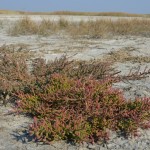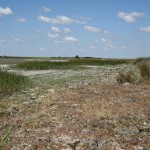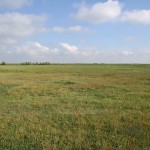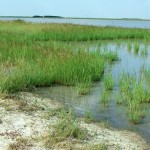Slano Kopovo, a very specific area, is characterized by special and rich plant cover. It is recognizable by special kind of salt marsh vegetation. Most of it is hardy, succulent, halophytes plants. They belong to community class Thero – Salicornietea . These plants are endangered species, not only here but in the whole Pannonian Plain.
Slano Kopovo coastal belt is rife with marsh vegetation. Typical reeds are the most common (ass. Scirpo-Phragmitetum phragmitetosum), but there is also bolboschoenetosum, asocial plant which grows on a salty ground and initiates poorly salinated and sodden ground. From the high sedge community there is Carici-Typhoidetum (Phalaridetum arundinaceae) species.
The salt marsh vegetation is dominated as a plant cover of the Reserve, despite its ephemeral features. This unvaried, Pannonian vegetation, usually grows during summer months when the water retreats. According to sodium-chloride concentration in the ground, the moisture of the ground and stratification process of it, we can clearly distinguish five types of fresh Thero-Salicornion.
Only here, in Serbia, you can find free from leaves, salt marsh plant – Salicornietum prostratae. In order to survive, this plant needs typically salty ground with the high concentration of sodium-chloride. Humidity factor is also very important. Its habitat is Salt Lake coast and during summer, when the water retreats, it lives in a muddy ground. Salicornia europaea is dominant species of the community. There are Crypsis aculeata, Puccinelia limosa and Spergularia marginata as well.
 Salicornieto – Suaedetum maritimae continentale community is described for the first time by Boža P. Knežević.A in 1988. The only place where this community can be found is the Pannonian Plain, in Serbia, in Slano Kopovo. The unique thing for this community is that the dominant species are Salicornia europaea and Suaeda maritime. They are described in the professional literature as plants which are mutually exclusive. When the water retreats, Salicornia europaea appears. This plant suits higher humidity of the ground. As the ground dries out, the dominant species becomes Suaeda maritime. At the end of vegetation period Puccinelia limosa, Spergularia media and Aster pannonicus appear.
Salicornieto – Suaedetum maritimae continentale community is described for the first time by Boža P. Knežević.A in 1988. The only place where this community can be found is the Pannonian Plain, in Serbia, in Slano Kopovo. The unique thing for this community is that the dominant species are Salicornia europaea and Suaeda maritime. They are described in the professional literature as plants which are mutually exclusive. When the water retreats, Salicornia europaea appears. This plant suits higher humidity of the ground. As the ground dries out, the dominant species becomes Suaeda maritime. At the end of vegetation period Puccinelia limosa, Spergularia media and Aster pannonicus appear.
 Suaedetum maritimae community supplements salt marsh, free from leaves vegetation in Slano Kopovo. It grows in semi-dry and dry periods (August – September). This is the community which has the shortest and the latest developing period. Except this dominant species, Suaeda maritime, there are also Salicornia europaea and Salsola soda.
Suaedetum maritimae community supplements salt marsh, free from leaves vegetation in Slano Kopovo. It grows in semi-dry and dry periods (August – September). This is the community which has the shortest and the latest developing period. Except this dominant species, Suaeda maritime, there are also Salicornia europaea and Salsola soda.
According to Boža P. Knežević A. (1988), there is a possibility that dominant species, Suaedeto – Kochietum prostratae, dissociate itself. It is noticed on the couple of square meters area, developed in fragments. There are three species in this community: Suaeda maritima and Kochia prostrate, but in small number and poor coverage. Puccinelia limosa is in some places and it needs to be checked is this other community specific for Slano Kopovo.
Suaedetum pannonicae community is noticed in the salt marsh Rusanda and Slano Kopovo. It is almost monoculture plant and its physiognomy, ecology and importance is determined by Pannonian Jurcic (Suaeda pannonica), which is an endemic species of the Pannonian Plain.
 There are meadow – steppe vegetation in the upper parts of the Reserve, continental salt marsh class – Festuco – Puccinellietea. These areas are occasionally flooded salty meadows with the species of Puccinellietum limosae, Camphorosmetum annuae and Hordeetum hystricis. They appear in the form of smaller oases, in line, where Puccinellietum limosae community grows in the moistest area and Hordeetum hystricis community grows in the driest area.
There are meadow – steppe vegetation in the upper parts of the Reserve, continental salt marsh class – Festuco – Puccinellietea. These areas are occasionally flooded salty meadows with the species of Puccinellietum limosae, Camphorosmetum annuae and Hordeetum hystricis. They appear in the form of smaller oases, in line, where Puccinellietum limosae community grows in the moistest area and Hordeetum hystricis community grows in the driest area.
At the edges of the Reserve and between Small and Slano Kopovo where the soil is not that salty, we can find typically meadow – steppe vegetation of the poorly salinated habitats – Statice gmelini.











 Follow
Follow